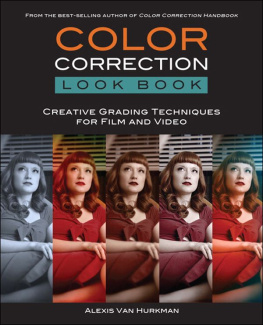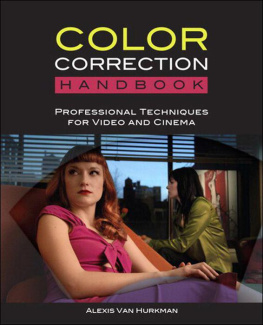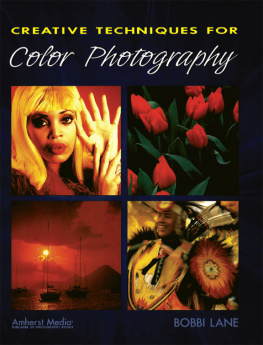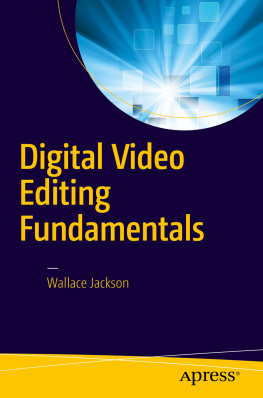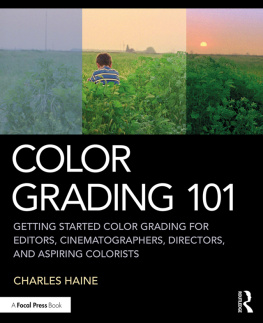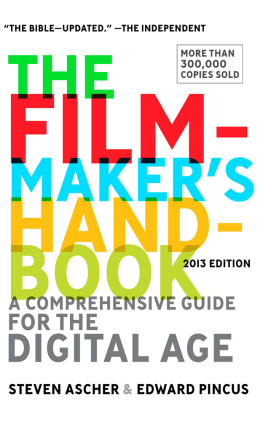Color Correction Look Book
Creative Grading Techniques for Film and Video
Alexis Van Hurkman
COLOR CORRECTION LOOK BOOK:
Creative Grading Techniques for Film and Video
Alexis Van Hurkman
Peachpit Press
Find us on the Web at www.peachpit.com
To report errors, please send a note to
Peachpit Press is a division of Pearson Education
Copyright 2014 by Alexis Van Hurkman
Senior Editor: Karyn Johnson
Development Editor: Stephen Nathans-Kelly
Production Editor: Maureen Forys, Happenstance Type-O-Rama
Copyeditor: Kim Wimpsett
Compositor: Cody Gates, Happenstance Type-O-Rama
Proofreader: Liz Welch
Indexer: Valerie Haynes Perry
Interior Design: Kathleen Cunningham
Cover Design: Aren Howell Straiger
Cover photo: Kaylynn Raschke
Cover models: Gal Friday
Images in the book and in the download are separately copyrighted by their respective owners. Please see the Introduction for more information.
Notice of Rights
All rights reserved. No part of this book may be reproduced or transmitted in any form by any means, electronic, mechanical, photocopying, recording, or otherwise, without the prior written permission of the publisher. For information on getting permission for reprints and excerpts, contact .
Notice of Liability
The information in this book is distributed on an As Is basis without warranty. While every precaution has been taken in the preparation of the book, neither the author nor Peachpit shall have any liability to any person or entity with respect to any loss or damage caused or alleged to be caused directly or indirectly by the instructions contained in this book or by the computer software and hardware products described in it.
Trademarks
Many of the designations used by manufacturers and sellers to distinguish their products are claimed as trademarks. Where those designations appear in this book, and Peachpit was aware of a trademark claim, the designations appear as requested by the owner of the trademark. All other product names and services identified throughout this book are used in editorial fashion only and for the benefit of such companies with no intention of infringement of the trademark. No such use, or the use of any trade name, is intended to convey endorsement or other affiliation with this book.
ISBN-13: 978-0-321-98818-8
ISBN-10: 0-321-98818-3
9 8 7 6 5 4 3 2 1
Printed and bound in the United States of America
Dedication
To Rod Gross, director and producer, who hired a green young editor and made him learn After Effects 3.0; I blame you for helping start me on a long and successful career.
Table of Contents
Introduction
Because you do not have to imitate, like painters, sculptors, novelists, the appearance of persons and objects (machines do that for you), your creation or invention confines itself to the ties you knot between the various bits of reality caught. There is also the choice of the bits. Your flair decides.
Henri Cartier-Bresson (19082004)
If youre reading this in the bookstore or online to see whether this book is for you, its important that you understand what this book is not. This book will not teach you the basics of color correction, nor will it teach you how to balance shots in a program to play as a seamless whole, how to isolate features of an image for specific adjustment, or how to achieve desirable skin tone. These topics are all covered in the Color Correction Handbook: Professional Techniques for Video and Cinema, which youre advised to read first if youre new to color grading.
This book will, on the other hand, show you how to have lots of visual fun stylizing the images your clients give you.
In the ideal world of some cinematographers, the photography of an image would be entirely controlled by the director of photography (DP), primarily via images captured in-camera, with whatever balance of light and shadow, interplay of glow and volume in the lighting, and intended color interaction conceived on the set, recorded faithfully, and enhanced carefully by the colorist under strict supervision for the eventual benefit of the audience. Gordon Willis, A.S.C., articulates this point of view in an interview with Casey Burchby in the May 23, 2013 LA Weekly:
In todays moviemaking, you have lost the integrity of the original image. Youve lost the integrity of the person whos thought things out and wants a certain thing to be achieved on the screen. Because if you dont have a contract that says no one can change anything, everyone who loves a dialand they all seem to love dialsgets ahold of it and things turn into magenta, they turn into yellow, they turn into some of the most insane applications of creative thinking. There are people who should know better, who have been making movies for a while, who get into this damn room with those dials and they start doing things they never would have thought of doing. They go, Well, were here. Lets blow up seven bridges.
Fair enough.
However, as anyone whos been in production knows, time and budgets are the enemy of grand plans for in-camera effects, and its often the case that the best intentions are defeated by the need to get through however many pages in a day are necessary to get back on track. This can make the effects contributions of the grading department essential to achieving a desired look.
Cinematographers whove gone through enough digital grades usually come to understand the range of options that a skilled colorist makes possible. The prudent cinematographer learns to incorporate the knowledge of what sorts of adjustments and looks are easy in post, andmore importantlywhich ones are not, and incorporates that knowledge into their shooting strategy.
Thus, the colorists job is no longer to simply balance, fix, and optimize. Stylizations and effects once created by the film lab are no longer photochemically available. In truth, you the colorist have become the lab, and these sorts of image stylizations are now part of your job description.
Additionally, in a world of increasingly flawless digital reproduction of radiometric light, the quality and consistency of digital image capture threaten to become boring, and its not uncommon for directors to long for the idiosyncrasies and imperfections of older recording methods. Or, they long for you to show them something completely different, to differentiate the look of a given project from the last 50 projects that were shot with that camera.
This book aims to present a useful collection of creative grading techniques designed to give you an arsenal of stylizations you can use when the client asks for something special, unexpected, and unique.
The techniques I present in this alphabetically organized book are the types of corrections youll make for music videos, advertising spots, and even re-creations and dream sequences within more conventionally graded programs, all of which will benefit from your ability to create something a little more wild. This book presents a variety of strategies that you can experiment with.
And thats the key: Ive worked to present techniques that are strategies more than they are looks. Most of the creative techniques Ive chosen to cover are highly customizable and can be tailored to suit your particular purposes. More likely, youll find yourself mixing and matching them in order to create your own unique effects. No two movies, spots, or series will have the same needs, although many of the stylizations you create can be categorized as variations on familiar, recognizable techniques.

